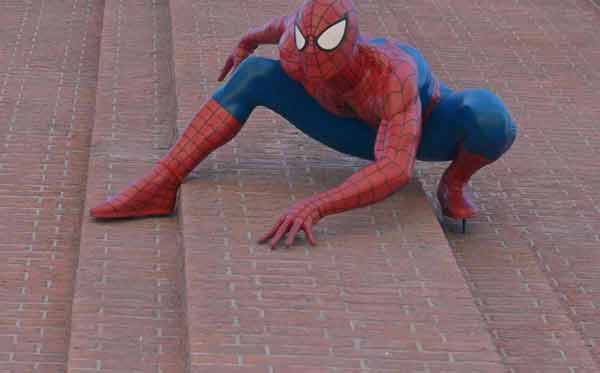
London, UK (BBN)-If Spider-man were real, he would be forever falling off vertical walls and struggling to maintain credibility as a superhero, research suggests.
British and Australian scientists have discovered the adhesive footpads that make spiders, tree frogs and geckos such amazing climbers are limited by body size, reports the Sky News.
They simply would not work for a creature as big as a human - unless he had impossibly large feet.
A person would need sticky pads covering 40 per cent of the body's surface to scale skyscrapers like Spider-man, according to the researchers.
In practical terms, that would equate to a European shoe size of 145, or US size 114.
The discovery may have implications for the feasibility of large-scale gecko-like adhesive systems.
Lead scientist Dr David Labonte, of Cambridge University's department of zoology, said: 'As animals increase in size, the amount of body surface area per volume decreases - an ant has a lot of surface area and little volume, and a blue whale is mostly volume with not much surface area.
'This poses a problem for larger climbing species because, when they are bigger and heavier, they need more sticking power to be able to adhere to vertical or inverted surfaces, but they have comparatively less body surface available to cover with sticky footpads.
'This implies that there is a size limit to sticky footpads as an evolutionary solution to climbing - and that turns out to be about the size of a gecko.'
Tiny mites used roughly 200 times less of their total body area for adhesive pads than geckos, the scientists found.
For animals bigger than lizards, nature had found more practical climbing solutions, such as gripping toes and claws.
The researchers compared the weight and footpad size of 225 climbing animal species including insects, frogs, spiders, lizards and even a mammal.
One solution to the scaling problem might be to make sticky footpads a whole lot stickier, the research published in the journal Proceedings of the National Academy of Sciences indicates.
Co-author Dr Christofer Clemente, of the University of the Sunshine Coast in Australia, said: 'We noticed that within closely-related species pad size was not increasing fast
enough to match body size, probably a result of evolutionary constraints.
Yet these animals can still stick to walls.
'Within frogs, we found that they have switched to this second option of making pads stickier rather than bigger.
It's remarkable that we see two different evolutionary solutions to the problem of getting big and sticking to walls.'
BBN/SK/AD